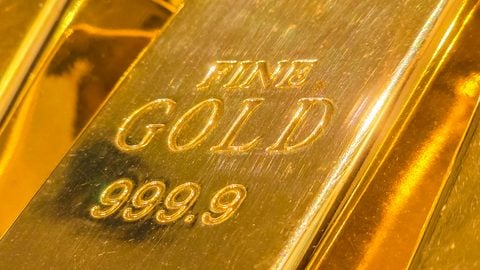Roundup: World Cup Tix, a New iPhone, Gold Fever & Pumpkin Spice
Soccer's World Cup comes to North America in 2026, and the long, crooked path to scoring tickets begins this week.

Many, or all, of the products featured on this page are from our advertising partners who compensate us when you take certain actions on our website or click to take an action on their website. However, this does not influence our evaluations. Our opinions are our own. Here is a list of our partners and here's how we make money.
Money news this week:
- The August jobs report shows cracks in the labor market are getting deeper.
- Powerball powered its way to an estimated $1.7 billion jackpot for Saturday’s draw.
- Mortgage rates could rise if the Fed doesn’t make a cut soon.
World Cup tickets: The qualifying rounds
Soccer’s biggest global tournament only comes around every four years, and for the 48 national teams that finally take the field in 2026 it will have been a long, long road — one that began back in September 2023 with the first qualifying rounds. Qualifying is still going on and doesn’t end until November.
The road is likewise long and arduous for fans who hope to see a game in person at the men’s World Cup, to be hosted jointly next year by North America, with games at 11 U.S. stadiums along with cities in Canada and Mexico. There hasn’t been a World Cup on U.S. soil since 1994 and American interest in the game has skyrocketed since then.
World Cup ticket interest has been bubbling since host sites were announced in 2022, and it spikes with every carefully planned announcement from tournament organizers FIFA, one of two rival governing agencies for world soccer.
Well, FIFA finally announced details of its ticket-selling process this week. And as someone who wouldn’t mind seeing a World Cup game in his hometown stadium, let me tell you this: It’s complicated.
Phase one: The Visa Presale Draw
First off, entering the draw doesn’t guarantee you tickets. Entering the draw gives you a chance to secure a future time slot during which you can attempt to buy tickets, but it’s always possible that everything you want is sold out by the time your turn comes. That is not necessarily great, but let’s be honest — unless you know somebody who knows somebody, this is probably the best chance you’ll get.

The draw opens Wednesday at 11 a.m. Eastern time and remains open until Friday, Sept. 19. Beginning Sept. 29, after a “randomized selection process,” successful entrants will be granted their ticket-buying appointment. For those entrants, ticket sales actually begin on Oct. 1. According to FIFA, tickets will be available for all 104 matches, including the final (to be held in New Jersey next July).
How much will tickets cost? Tickets will begin at $60 for group stage matches and range up to $6,730 for the final. FIFA will deploy a dynamic pricing system, which means demand can (and probably will) drive prices higher. A quick glance at ticket-scalping sites like StubHub shows that sellers are already marketing tickets for, in some cases, tens of thousands of dollars. Tickets they don’t (yet) possess.
Keep in mind that group draws don’t happen until December, so you won’t know who’s playing in those group match games until then.
Who qualifies for the first ticket draw?: As you might have guessed, the “Visa Presale Draw” is so named because you need to be a “qualifying Visa cardholder” to play.
Will there be other chances to buy tickets? The next early ticket draw (no Visa requirement) will be Oct. 27-31, and there will be two final draws in December. There will also be “last minute sales” next year as the tournament approaches, according to FIFA.
What’s the next step?: Go to the World Cup tickets site and “register your interest” in buying tickets. This gets you into the system and gives you a “FIFA ID” (probably your email address). Do that before you enter a ticket draw, and you will get email alerts on what to do next.
And good luck to all of us.
Apple fans, get ready for the new iPhone
The first iPhone was introduced in June 2007. All these years later, it remains the most popular smart phone in the United States, and is still the center of an annual frenzy of speculation in advance of new product announcements.
Apple will hold what it’s billed as an “Awe Dropping” event on Tuesday, at which it is expected to reveal its iPhone 17 lineup among other shiny new things (new Apple Watches, new AirPods, a next-generation AirTag).
There are plenty of sites that will give you a fevered rundown of predicted specs and price points (here’s one, here’s another), but that’s not what we’re about.
Instead, we’ll just ask a practical question: When is it time to upgrade your iPhone?
Over time, iPhone users have been gradually holding onto their phones longer — nearly four years, on average — as new model releases become more evolutionary than revolutionary.
For common advice on when to upgrade, we scoured Reddit* (and yes, AI helped). Turns out the leading strategies tend to be conservative:
- Many users say they upgrade every four to five years, as phones now are built to last that long, especially with a battery replacement.
- Several commenters noted that year-to-year changes are now so incremental that changes are only noticeable from models that are three to four years old.
- Some users say they optimize for trade-in value by upgrading every other year.
- There are still power users who upgrade every year, because they need the new features for work or other specific uses.
- But the prevailing sentiment, as summarized by one user: “Buy a phone when you need it, not when you want it."
For the record, I’ve had my iPhone 13 for at least three years. And while I’m tempted by the latest phone upgrades rumored for iPhone17, I plan to hold onto my old phone for at least another year.
Caveat: Some analysts are predicting that the integration of AI features into smartphones will lead buyers to upgrade more often. The iPhone 17 is expected to include several AI enhancements.
Gold fever

The price of gold is rising and hit another record at the close of the week, touching $3,654 and change in midday trading on Friday. Gold closed out 2024 at $2,641 an ounce, meaning it has risen some 35% so far this year. The S&P 500 is up a little over 10% in that same span.
Gold prices are notoriously volatile, but observers foresee more gains in the year ahead. In June, financial services firm J.P. Morgan, citing “trade uncertainty and geopolitical risks,” predicted prices would rise toward $4,000 by the second quarter of 2026. Newer forecasts are setting sights even higher.
“Currently, we predict the price will reach $5,000 per ounce by the end of the first quarter of 2026,” according to Nigel Green, CEO of the deVere Group, another financial services giant. “The drivers are already in place and momentum is compounding.”
So what’s going on, in a nutshell? For one, gold often rises in times of economic uncertainty — like now, amid the current U.S. trade war and White House attacks on the Fed. Analysts at the deVere Group listed several factors at play in the current rise of gold.
- The dollar has weakened: The value of the U.S. dollar, as measured against a basket of foreign currencies, has fallen precipitously since January. That makes gold cheaper for foreign buyers.
- Central banks are buying: In particular, China and India are buying gold at accelerated rates. According to the World Gold Council, central banks have bought up more than 1,000 metric tons of gold in each of the last three years, double the rate over the preceding decade.
- Gold ETFs: Exchange-traded funds that are physically backed by gold are booming in 2025. Collectively, in the first half of the year, gold ETFs added more than 379 tons of the metal to their holdings.
There are enthusiastic individual investors as well, but again, gold is volatile and not an appropriate investment for everyone — even if you can buy gold bars at Costco. Here’s our take on how to buy gold (and, how to sell it).
The pumpkin spice trade

Spices were once almost as rare and coveted as gold, and like gold their prices may soon be booming — just in time for pumpkin spice season.
Starbucks started the fall craze with the introduction of its pumpkin spice latte as a test in 2003, and now you can find a pumpkin spice variation on just about every food item you can name.
The traditional pumpkin spice blend includes cinnamon, nutmeg, ginger, cloves and allspice, all of which grow in tropical conditions. So we import them from places like spice powerhouse India, which is now subject to a 50% tariff.
Spice prices appear destined to rise, but for now the price of a pumpkin spice latte has not gone up.
ICYMI: 68 jobs get tax break for 2025
Do you get tipped on the job? Starting with the 2025 tax year, up to $25,000 in tipped income is tax-exempt for a whopping 68 occupations.
That list includes the usual suspects like housecleaners, servers, hair stylists and delivery drivers. But there are some surprising positions that made the cut like digital content creators, plumbers and electricians.
Find out if your job would qualify and how to get the tax break.
Here’s what else you may have missed this week:
- Patience pays off for home buyers who wait until fall to buy a house.
- We’re facing yet another government shutdown threat.
- New bonuses have dropped for two IHG One Rewards credit cards.
- Three years later, crypto credit cards are back.
Next week: Is inflation reigniting?
Fresh inflation data is coming next week showing data for August. Here’s what NerdWallet Senior Economist Elizabeth Renter expects to see in those reports:
Sept 10: Producer Price Index (wholesale inflation), Bureau of Labor Statistics (BLS) — Producer price growth spiked last month, and while I anticipate we’ll see continued strong inflation here, it may not top the 0.9% month-over-month reading we saw in July’s data.
Sept.11: Consumer Price Index (consumer inflation), BLS — Core inflation exceeded the 3% mark last month, and we’re unlikely to see signs of relief in August’s data. That said, a large spike is unlikely and anything aside from that will fuel bets for a rate cut at the next Fed meeting.
* Reddit is an online forum where users share their thoughts in “threads” on various topics. The popular site includes plenty of discussion on financial subjects, so we sifted through Reddit forums to get a pulse check on how long users keep their iPhones. People post anonymously, so we cannot confirm their individual experiences or circumstances.
Article sources
NerdWallet writers are subject matter authorities who use primary,
trustworthy sources to inform their work, including peer-reviewed
studies, government websites, academic research and interviews with
industry experts. All content is fact-checked for accuracy, timeliness
and relevance. You can learn more about NerdWallet's high
standards for journalism by reading our
editorial guidelines.
Related articles














